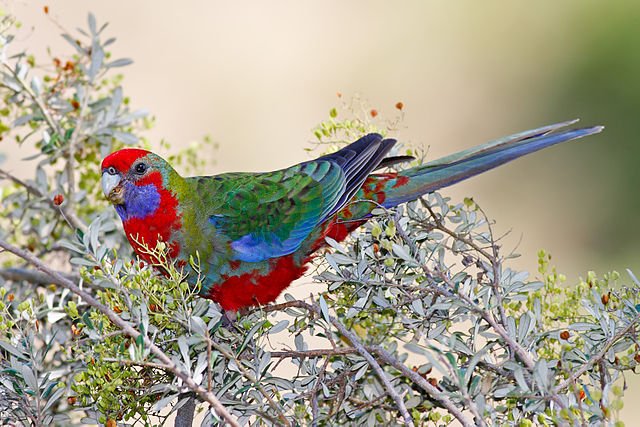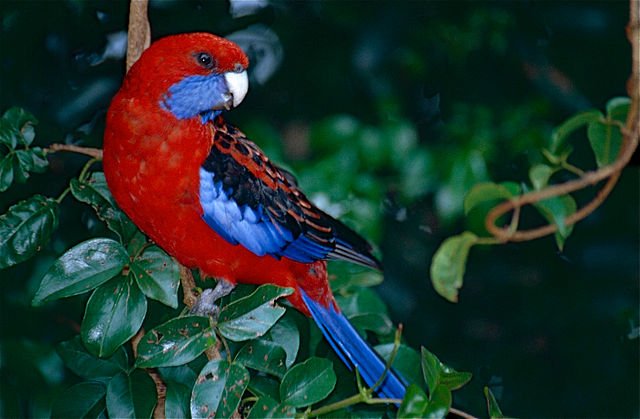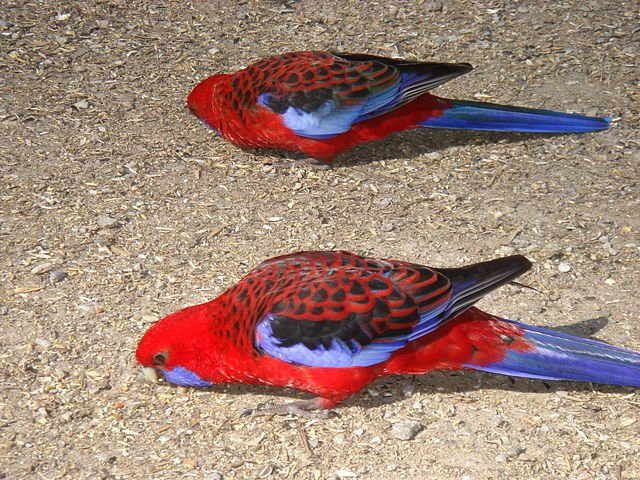Crimson Rosellas are among Australia’s showiest parrots for their natural beauty. They are natives to Australia’s eastern as well as south-eastern regions including the wild areas of Tasmania. These little creatures get attracted to parks, woodlands, gardens, and open forests. So, it is natural for them to find comfort in the wilderness of Tasmania. Along with the wild areas, they are often found in the parks and reserves of the island state because of their natural inclination to these habitats.
Commonly found Rosellas in Tasmania
Tasmania is a house for many Rosella breeds including both Green and Crimson Rosellas. Green Rosellas dominate the region and, hence, called Tasmanian Rosella as well. Due to some similarities between these two breeds of Rosellas, they are often confused with each other.
Green Rosellas display green plumage in both adults and juveniles. Crimson Rosellas, on the other hand, have an olive green plumage when juvenile. This makes the juvenile Rosellas of both these species look similar in wild Tasmania.
Another confusion between these species occurs with the similarity between Green Rosellas and Yellow Rosellas. Yellow Rosellas are a subspecies of Crimsons. They showcase a yellow tone to their rump and its underparts. At the same time, Green Rosellas are called as yellow-bellied sometimes for the appearance of yellow color on the head, neck, and underparts. This similarity again causes confusion between these two Rosella species.
Crimson Rosella behavior in Tasmania
In wild Tasmania, Crimson Rosellas reside in the dense forest regions. The early mornings see these birds flying around in the wild in search of water and food. In the afternoon, they can be found at the higher parts of the trees as they like to build their nests in hollowed-out tree trunks. This is their resting time. Early evenings are their feeding time which is followed by resting again.
In their natural occurrence, they display a variety of colors ranging from red, yellow, orange, and green. While traveling across the wilderness of Tasmania, they form small flocks. These flocks are noisy when it leaves for the day’s first feed in the morning and also during its last return of the day, i.e., the evenings. These little creatures carry loads of energy and fly rapidly between the tree trunks with steep turns. These birds take their sleep during nights.
Crimson Rosella feeding habits in wild Tasmania
Crimson Rosellas love eating fruits and seeds of eucalyptus so much so that they are considered pests of orchards. With a wide range of eucalyptus trees in Tasmania, these species have their platters always ready.
They also feed on shrubs, grass, weeds, acacias, and pines for both grains and seeds. In the shaded regions of the wild, they might also be seen foraging seeds on the ground. Apart from this, Crimsons eat berries, nectar, and flowers. Though they are mostly herbivorous, they might feed on insects like mealworms to fulfill their protein requirements during their breeding season. They consider insects an easily-digestible protein form.
Crimson Rosella breeding in Tasmania
In wild Tasmania, the males of Crimson Rosellas do the job of wooing their mate with a mating call. This mating call is followed by a bow down gesture near the mate he’s trying to woo. The female Crimson will respond similarly if interested. If the mating calls are ignored by the female, the male will try to find another mating partner. Once two interested mates are together, a mutual feeding takes place which is later followed with mating.
Crimson Rosella nesting in the wild
Crimson Rosellas dwell in a meter deep hollowed-out tree trunk. Selecting an appropriate nesting site is the duty of female Crimson among the pair. Usually, these sites are situated at around 30 meters above in the wild tree cavities.
Due to their natural inclination towards Eucalyptus trees, most of the Crimson Rosella nests can be found on these trees. Also, trees that are near to a natural water body are preferred over the rest for building a nest.
Once an appropriate site is chosen for their nest, the pair moves ahead with the nest preparation. Wood dust and shavings are formed from the surroundings for lining the nest interiors. The pair works hard in shredding the surrounding hollow area with their beaks as they are unwilling to introduce any outside material like twigs into their nest.
Crimson Rosellas do not like sharing their nest with other pairs like Quaker parrots. They do not allow any flock member to enter their season’s dwelling and start chattering and bickering to stop them if the need arises. They ensure to keep other Crimson pairs away from the immediately surrounding trees as well and do not allow them to make nests nearby. To safely raise their young one in the nest, it is guarded from outside by either of the partners all the time.
How do Crimson Rosellas communicate in wild Tasmania?
Crimson Rosellas are playful, chirpy, and noisy all the time. They are silent only when they are feeding upon something. The communication ability of Crimson Rosellas cannot be referred to as their talking ability. They can, however, mimic various songs and whistles.
For communicating, they use a wide range of contact calls in their natural habitat, several of which are melodious. Here are some of the sounds they use for communicating:
A two-syllable sound of ‘cussik-cussik’ is their favorite for calling their flock member from a distance.
When they are in flight, they use the sound of ‘kwik-kwik’ for communication.
A soft chattering sound of ‘pi-pi-pi-pi’ is used by Crimsons when they roost in groups.
When they are in fear, they produce a screechy sound with a high shrill.
Health issues faced by Crimson Rosellas in the wild
Crimson Rosellas have an average life expectancy of twenty to thirty years. Their quality of life and longevity increases to a large extent, when in captivity. In wild Tasmania, many Crimsons might not even touch 25 years because of the lack of care and support from humans. To add to this, there are numerous health problems that this species is susceptible to. Let us find out more about the health concerns of Crimson Rosellas:
Intestinal Worms
These birds forage at the ground level in search of seeds and grains which makes them susceptible to parasites and intestinal worms. This makes them less active as their overall energy is negatively impacted by the live parasites that entered their body. Also, their appetite might reduce slowly causing further health problems.
Fungal infection
There are also high chances of Crimsons catching a fungal infection. These birds live around the damp areas that expose them to the risk of catching fungal or bacterial infections. This health problem might lead to diarrhea, lethargy, difficulty in breathing, weight loss, and loss of voice.
Parrot fever
Parrot fever or psittacosis is also common among this species. It is a bacterial infection that usually reduces the infected Crimson’s appetite. It is a serious health issue that might lead to weight loss, sleepiness, discharge from nose or eyes or both, diarrhea, and discolored droppings.
These health problems faced by Crimson Rosellas in their natural habitat makes their lives shorter. There is no human intervention to cure them from a disease at the very first stage of its occurrence.
Other problems faced by Crimson Rosellas in wild Tasmania
The biggest problem that Crimson Rosellas face in the wild is predators. The Crimson predators include owls, peregrine falcon, foxes, grey goshawk, and feral cats. The other major problem includes attacks performed on their eggs. Currawongs, Possums, and other female Crimson Rosellas are a threat to their eggs. The predators mentioned above can also attack the nest of Crimsons for the want of eggs.
The females of the neighboring Crimson pairs show such destructive behavior to secure the best nesting place for themselves. In other words, if the female Crimson feels that a particular place is best suitable for building a nest, she’ll attack the existing nest at that particular spot. Once all the eggs of a pair are destroyed, the nest is abandoned by the existing pair and the dominating pair takes the spot.
This monopoly of the stronger pair remains for the years to come. Therefore, for successful hatching of the chicks, it becomes important for the pair to save the eggs from the Crimson pairs in the neighborhood. This also ensures a safe dwelling for them in the future.
The Final Words
Crimson Rosellas are native to the dense forest regions of Tasmania and other parts of Australia. They enjoy their freedom in the wild and can be seen chirping happily with their flock mates. They also have access to a lot of free area for their long flights as against limited space in captivity. But due to lack of human intervention, their average age is negatively impacted. The diseases they encountered cannot be arrested by anyone and treated for. There are also risks of predators attacking them and their eggs. But in the end, it is their natural habitat and they love spending time around the wild forests.
Check out some other Crimson Rosella Articles:
Crimson Rosella Breeding:
https://parrotquaker.com/crimson-rosella-breeding-information/
Crimson Rosella Colors
https://parrotquaker.com/crimson-rosella-colors/





